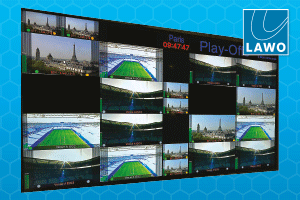Greater technology choice is leading customers down the path of the single vendor option for all their primary equipment, with the promise of a unified control system or at least, a minimisation of the number of protocols involved. However, even with the best of intentions, many vendors are not control and monitoring experts […]

Greater technology choice is leading customers down the path of the single vendor option for all their primary equipment, with the promise of a unified control system or at least, a minimisation of the number of protocols involved. However, even with the best of intentions, many vendors are not control and monitoring experts why should they be? and solutions can be half-hearted or out-of-date. Why should customers be forced to relinquish real choice when it comes to equipment selection?
Customers want to be able to buy best-of-breed devices from multiple manufacturers, be that branding technology, routers, video servers, VTRs, multi-image display processors and modular gear, or any combination thereof. But this means despite the often best intentions of the manufacturers there is a huge range of control and monitoring interfaces and masses of functionality that in reality will never be used in an on-air environment. This leads to a consequent inability for operators to move quickly between channels to problem solve or access a particular function, never mind a complex workflow. Being forced to use multiple control interfaces, often using tiny screens and buttons that require flicking through simply to find the one function out of thousands that you require, is deeply inefficient.
A PC-based control system, providing the ability for user-defined control panels and complex workflows that can be activated at the touch of a button, offers new possibilities for accurate on-air control.
A primary challenge for a unified control system is to understand the myriad protocol standards and those that are proprietary.
With a unified on-air control technology, the drivers must be bundled into the application so theres no different installation process.
At the most fundamental level, it will let users clear control room desks of equipment-specific hardware control panels and set up a manual control system that focuses on the tasks that operators actually carry out. Instead of training operators in the details of every manufacturers particular control system, customers can put in front of them onscreen buttons, faders, etc., labelled according to the task they accomplish such as logo on, logo off, commentary level and so on. The control system will then take care of translating these into commands for the various pieces of broadcast hardware in an installation.
This makes everyday operations much easier, allowing staff to concentrate on their real job of broadcasting great content instead of wasting their energies on figuring out how to do it. It also makes systems safer. Emergency operations, which are not part of operators daily lives, can be packaged as single button presses so that in the event of a problem, they can quickly take action.
Not only does a unified system provide the core benefit of highly streamlined and fit-for-purpose manual control, it also creates additional efficiencies when it comes to staff training. This is vital in an era where deskilling is unfortunately though understandably part of the economic and technological landscape. User-definition allows engineers to create complex workflows that operators can trigger at the touch of a button. New users can be trained to carry out what would be otherwise impossible, or at best, massively time-consuming tasks. Operators only have to learn one piece of technology rather than all the discrete technologies and their interfaces. Staff can be brought up to speed quickly and cost-effectively.
Another key issue is the relationship between such a control system and modern automation technologies. Since other control systems like automation may also be sending commands, its important that a unified solution keeps track of the internal state of the pieces of broadcast equipment its managing. Some broadcast equipment sends status changes automatically while others wait for a status request depending on the manufacturers control protocol.
To put it simply, a unified control system can move the complexity of broadcast operations away from operators, giving efficient access to workflows that provide a satisfying viewing experience with the additional advantage of a monitoring safety net.
Roddy Pratt is Technical Director at Rascular.


































































